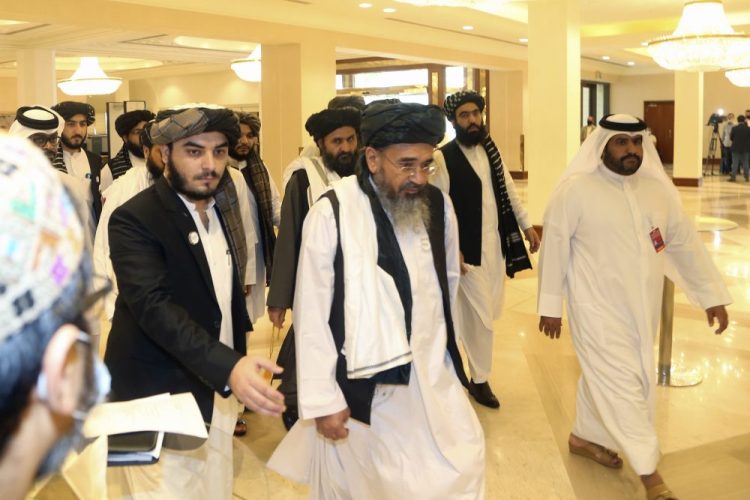DOHA, Qatar — The Afghan people were looking to the government and the Taliban to achieve peace at historic talks in Qatar, officials said at the formal opening of the negotiations on Saturday.
“We have come here with the goodwill and good intention to stop the 40 years of bloodshed, and achieve a countrywide and lasting peace,” the chairperson of Afghanistan’s High Council for National Reconciliation, Abdullah Abdullah, said at the ceremony in a Doha hotel.
As the government delegation called for a “humanitarian cease-fire,” the Taliban side also started to lay out its demands.
The militants said it wanted an “inclusive Islamic system,” and the release of at least 8,000 more Taliban prisoners. Thousands were already released in the lead-up to the talks in Doha.
“If there is determination and intention the issues can be resolved,” said Suhail Shaheen, a member of the Islamist militants’ negotiating team.

Abdullah Abdullah, center, chairman of Afghanistan’s High Council for National Reconciliation, talks at the opening session of the peace talks between the Afghan government and the Taliban in Doha, Qatar, Saturday. (AP Photo/Hussein Sayed)
The head of the Taliban delegation, Mullah Abdul Ghani Baradar, said that the U.S. must remain committed to the agreement it signed with the group in February, which helped pave the way for the current talks.
The deal envisaged the gradual withdrawal of international troops from Afghanistan.
The chief Afghan negotiator, Masoom Stanekzai, said that the main focus of his team would be establishing a lasting cease-fire.
The “people of Afghanistan should not continue in the negotiations and in conflict simultaneously,” he said.
U.S. Secretary of State Mike Pompeo addressed the delegates in his speech: “You carry great responsibility, but you are not alone. The entire world wants you to succeed.”
“We welcome the Taliban commitment not to host international terrorist groups, including al-Qaida, nor to allow them to use Afghan territory to train, recruit or fundraise,” Pompeo added.
The Taliban – which had previously ruled Afghanistan under strict Islamic laws – was ousted from Kabul by the U.S.-led invasion in 2001 that followed the Sept. 11 terrorist attacks that year.
Pakistan’s Foreign Minister Shah Mehmood Qureshi also addressed the gathering via video, saying his country supported the talks and that “there was no military solution to the Afghan conflict.”
Pakistan has long been accused by the Afghan government of arming, training, and funding militants who are based on their shared border and have carried out attacks in Afghanistan.
The NATO military alliance and the European Union both welcomed the launch of peace talks.
NATO, which gives military backing to the Kabul government, said that it would be willing to “adjust” its presence in Afghanistan “if conditions allow” in order to support the peace process.
The alliance’s governing council also called on the Taliban to “take decisive steps toward ending violence,” charging that the Islamist movement’s attacks were keeping violence at an “unacceptably high” level.
United Nations Secretary-General Antonio Guterres said that “women should participate meaningfully in the process,” although few women are taking part in the talks. Out of the teams of 21 people on each side, the Afghanistan delegation has at least four women, but the Taliban has none.
The first substantive discussions are expected to begin on Sunday. The talks were initially scheduled for March 10, but were delayed until the conclusion of a lengthy prisoner swap between the Afghan government and the Taliban.
In the swap process, some 5,000 Taliban prisoners, and 1,000 Afghan forces’ prisoners were released.
Afghanistan has effectively been at war since the Soviet Union’s invasion in 1979. In the nine years of the Afghan war with the Soviets, at least 1 million civilians were killed.
In the last decade, at least 100,000 civilians are estimated to have been killed or injured in Afghanistan.
Copy the Story LinkSend questions/comments to the editors.



Success. Please wait for the page to reload. If the page does not reload within 5 seconds, please refresh the page.
Enter your email and password to access comments.
Hi, to comment on stories you must . This profile is in addition to your subscription and website login.
Already have a commenting profile? .
Invalid username/password.
Please check your email to confirm and complete your registration.
Only subscribers are eligible to post comments. Please subscribe or login first for digital access. Here’s why.
Use the form below to reset your password. When you've submitted your account email, we will send an email with a reset code.